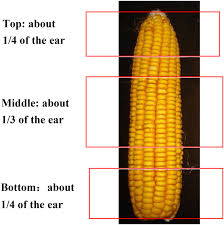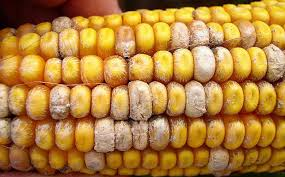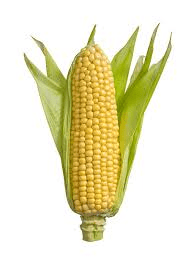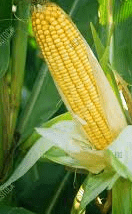The maize/corn ear is a critical reproductive structure in the life cycle of the maize plant (Zea mays). Scientifically referred to as the inflorescence, the ear is composed of several distinct components that play essential roles in the process of pollination, fertilization, and seed development. Understanding the anatomy and physiology of the maize ear is fundamental to comprehending the growth and productivity of this staple crop.
At the core of the maize ear lies the central axis, known as the cob or receptacle. The cob serves as the structural foundation for the ear, providing support for the attachment of the kernels and facilitating the transport of nutrients and water. Surrounding the cob are rows of modified leaves known as bracts or husks.
These bracts form a protective covering for the developing kernels, shielding them from external threats such as pests, diseases, and adverse weather conditions. Additionally, the bracts help regulate moisture levels and temperature within the ear, creating an optimal microenvironment for kernel development.
Radiating outward from the cob are the rows of kernels, each attached to a specialized structure called a pedicel. The pedicel connects the kernel to the cob and serves as a conduit for the transfer of nutrients and water from the parent plant. The kernels themselves are the seeds of the maize plant, containing the embryo and endosperm necessary for germination and growth.
The number of kernels per ear can vary widely depending on factors such as genetics, environmental conditions, and agricultural practices.
Above the kernels, protruding from the top of the ear, is the silk, a collection of long, thread-like structures known as styles. Each silk corresponds to an individual kernel and serves as the stigma, the receptive surface for pollen grains during the process of pollination.
The silk captures pollen released from the tassels, the male reproductive organs of the maize plant, and guides it to the ovaries located at the base of each kernel. Successful pollination results in fertilization, leading to the development of viable seeds within the kernels.
The development of the maize ear is a dynamic process that unfolds over several stages. It begins with the emergence of the tassel, which produces pollen grains containing the male gametes. As the tassel matures, it releases pollen into the air, where it is carried by wind currents to the silks of nearby ears.
Meanwhile, the ovaries within the kernels undergo rapid cell division and expansion, eventually filling out to form plump, mature seeds. Throughout this process, the plant relies on a steady supply of nutrients and water, which are transported from the soil through the roots and stems to the developing ear.
Once the kernels have reached maturity, the maize ear is ready for harvest. Farmers typically monitor the progress of the crop, looking for signs such as drying and browning of the husks and kernels. Harvesting is typically done mechanically, with specialized equipment used to remove the ears from the plants.
The harvested ears are then processed to separate the kernels from the cob, after which they may be used for various purposes such as human consumption, animal feed, or industrial processing.
In summary, the maize ear is a complex and vital structure that plays a central role in the reproductive cycle of the maize plant. From pollination to harvest, each component of the ear contributes to the successful production of seeds, ensuring the continuation of this essential crop in agriculture and food systems around the world.
The Economic Importance and Uses of Maize/Corn Ear

1. Human Consumption: Maize ears are a staple food in many parts of the world, consumed in various forms such as fresh, cooked, or processed into products like cornmeal, tortillas, and popcorn.
2. Livestock Feed: Maize ears are a valuable component of animal feed, providing essential nutrients and energy for livestock such as cattle, pigs, and poultry.
3. Industrial Processing: Maize ears are processed into a wide range of industrial products, including corn syrup, corn oil, and ethanol, which have diverse applications in food, fuel, and manufacturing industries.
4. Seed Production: Maize ears are a source of high-quality seeds for planting, contributing to the production of maize crops worldwide and supporting agricultural livelihoods.
5. Export Revenue: Maize ears and products derived from them generate significant export revenue for countries that produce surplus crops, contributing to economic growth and development.
6. Ethanol Production: Maize ears are a key feedstock for ethanol production, a renewable fuel used in transportation and industrial applications, reducing reliance on fossil fuels.
7. Biodegradable Packaging: Components of maize ears, such as husks and fibers, are utilized in the production of biodegradable packaging materials, offering sustainable alternatives to conventional plastics.
8. Textile Industry: Fibers extracted from maize ears are used in the textile industry to produce fabrics, ropes, and other textile products, diversifying income sources for farmers.
9. Pharmaceutical Industry: Maize ears contain compounds with potential medicinal properties, leading to applications in the pharmaceutical industry for the development of drugs and supplements.
10. Soil Amendment: Maize ears, when decomposed, enrich the soil with organic matter, improving soil structure, fertility, and productivity for future agricultural cycles.
11. Horticulture: Maize ears and husks are used in horticulture for mulching, composting, and soil conditioning, promoting plant growth and health in gardens and landscapes.
12. Animal Bedding: Dried maize ears and husks serve as bedding material for livestock, offering comfort, insulation, and absorbency in animal housing facilities.
13. Biochar Production: Charred maize ears can be converted into biochar, a soil amendment that improves soil fertility, carbon sequestration, and crop yields in agriculture.
14. Craft and Art: Maize ears and husks are used in traditional crafts and art, including decorations, sculptures, and ornaments, preserving cultural heritage and promoting artistic expression.
15. Food Processing: Maize ears are processed into a variety of food products such as canned corn, cornflakes, and cornstarch, meeting consumer demand for convenient and nutritious foods.
16. Renewable Energy: Maize ears contribute to renewable energy production through biogas production from anaerobic digestion of organic residues, supporting sustainable energy initiatives.
17. Environmental Conservation: Maize ears and their derivatives play a role in environmental conservation efforts, including soil conservation, carbon sequestration, and biodiversity preservation.
18. Agricultural Research: Maize ears are essential resources for agricultural research and development, facilitating studies on genetics, breeding, agronomy, and crop improvement to address global food security challenges.
Read Also : How to Prevent Cannibalism in a Fish Pond
The Products and By-products That Can Be Derived From Maize/Corn Ear

1. Cornmeal: Ground maize kernels used in cooking and baking.
2. Corn Syrup: Sweet syrup derived from maize starch, used as a sweetener in food and beverage production.
3. Corn Oil: Oil extracted from maize kernels, used in cooking, frying, and food processing.
4. Ethanol: Biofuel produced from maize fermentation, used as an alternative fuel for vehicles and machinery.
5. Animal Feed: Maize ears and kernels are essential components of animal feed for livestock and poultry.
6. Biodegradable Packaging: Husks and fibers from maize ears are utilized in the production of eco-friendly packaging materials.
7. Textile Fibers: Fibers extracted from maize ears are used in textile production for fabrics and other textile products.
8. Medicinal Compounds: Maize ears contain compounds with potential medicinal properties, used in pharmaceutical research and drug development.
9. Biochar: Charred maize ears are converted into biochar, a soil amendment that improves soil fertility and crop yields.
10. Craft Materials: Maize ears and husks are used in traditional crafts and art for decorations, sculptures, and ornaments.
11. Canned Corn: Processed maize kernels preserved in cans for extended shelf life and convenience.
12. Cornflakes: Breakfast cereal made from processed maize kernels, popular worldwide.
13. Cornstarch: Starch extracted from maize kernels, used as a thickening agent in cooking and food processing.
14. Biogas: Methane gas produced from anaerobic digestion of organic residues, including maize ears, used for heating and electricity generation.
15. Soil Amendment: Decomposed maize ears enrich the soil with organic matter, improving soil fertility and structure.
16. Livestock Bedding: Dried maize ears and husks serve as bedding material for livestock, offering comfort and absorbency.
17. Environmental Conservation: Maize ears contribute to environmental conservation through soil conservation, carbon sequestration, and biodiversity preservation.
Read Also: White Persian Cat Breed Description and Complete Care Guide
Frequently Asked Questions (FAQ’s) About Maize/Corn Ear

1. What is a maize/corn ear?
A maize/corn ear is the reproductive structure of the maize plant containing the kernels, cob, and husks.
2. How is a maize/corn ear used?
Maize/corn ears are used for human consumption, animal feed, industrial processing, seed production, and various other applications.
3. What products are derived from a maize/corn ear?
Products derived from maize/corn ears include cornmeal, corn syrup, corn oil, ethanol, animal feed, biodegradable packaging, textile fibers, and medicinal compounds, among others.
4. What are the economic importance and uses of maize/corn ears?
Maize/corn ears have significant economic importance as a staple food, feedstock for industries, source of export revenue, and contributor to renewable energy production.
5. What role do maize/corn ears play in agriculture?
Maize/corn ears are crucial in agriculture as they are the primary reproductive structures responsible for seed production. They contribute to crop yield, genetic diversity, and farm income, making them essential for global food security.
6. Can maize/corn ears be used for animal feed?
Yes, maize/corn ears are an important component of animal feed for livestock, providing essential nutrients, energy, and roughage for healthy growth and production.
7. How are maize/corn ears harvested?
Maize/corn ears are typically harvested mechanically using specialized equipment such as combine harvesters. The entire plant is often harvested, and the ears are separated from the rest of the plant during processing.
8. What are some environmental benefits of maize/corn ears?
Maize/corn ears contribute to environmental conservation through soil improvement, carbon sequestration, and biodiversity preservation. They also support sustainable farming practices such as conservation tillage and crop rotation.
9. Are there any alternative uses for maize/corn ears?
In addition to traditional uses, maize/corn ears have potential applications in biodegradable packaging, textile production, biofuel production, and pharmaceuticals, highlighting their versatility and economic value.
In conclusion, maize/corn ears are versatile agricultural commodities with a wide range of economic importance and uses. From food and feed to industrial applications and environmental conservation, maize/corn ears play a vital role in supporting livelihoods, industries, and ecosystems worldwide.
Read Also: Tillandsia Care Made Easy: A Comprehensive Guide

